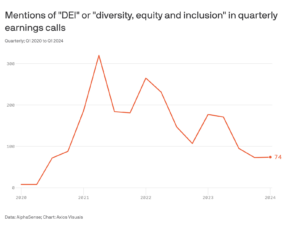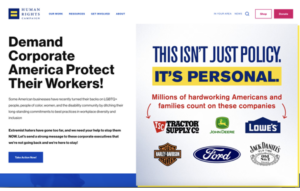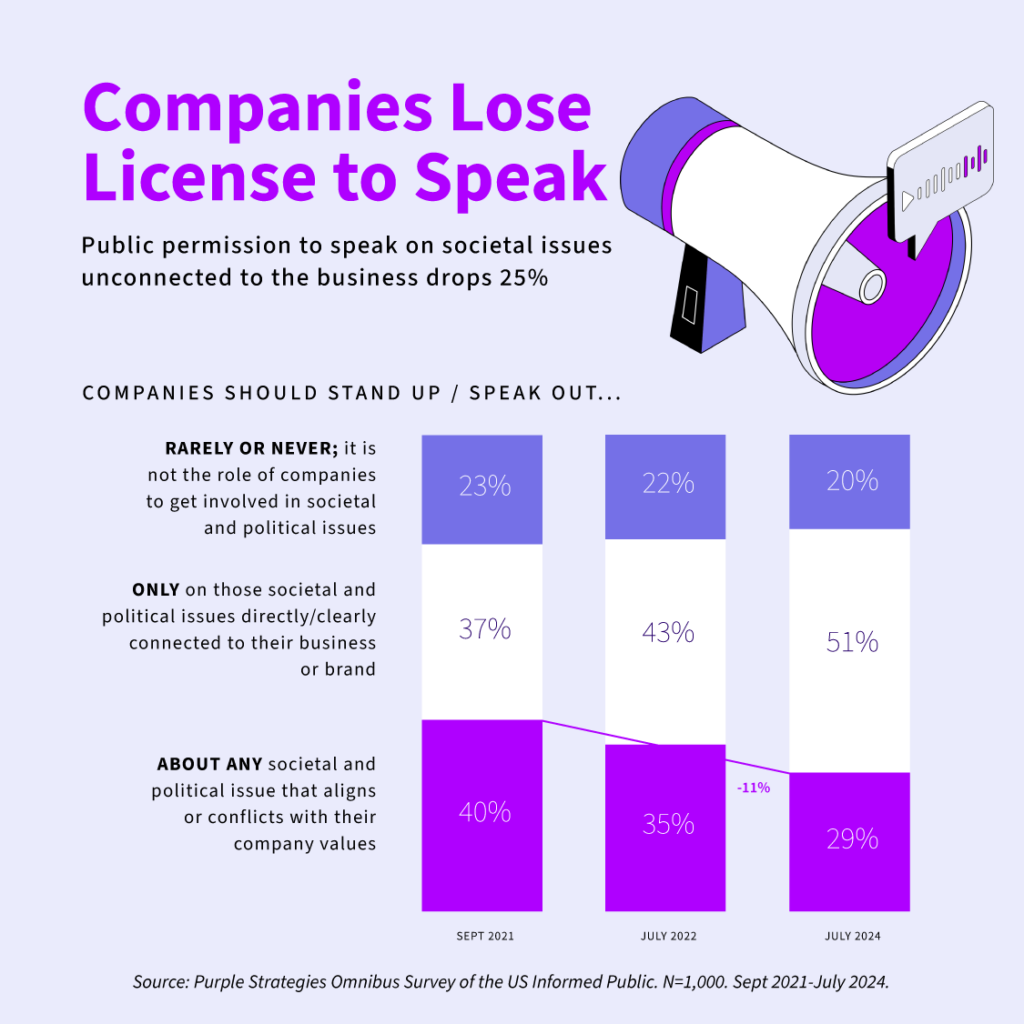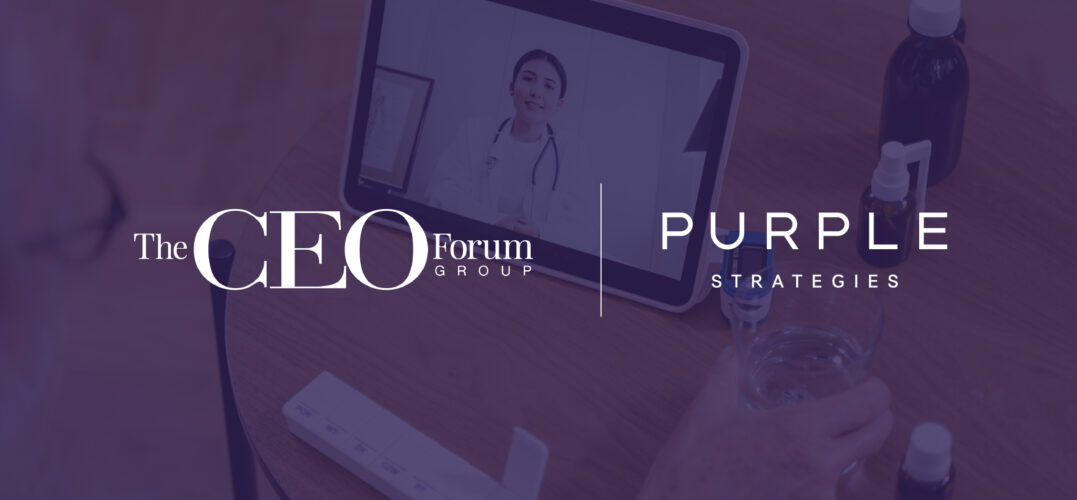Uncategorized

Posted on
December 13, 2024
5 Min. Read
Author
Purple Strategies
Turning a Corporate Risk into a Brand Opportunity
Straight to the Point
WHAT WE SEE: As the Trump administration takes office in January, companies may be presented with unpredictable corporate reputational risks at a moment’s notice. For an example, just look at McDonald’s. On the campaign trail, McDonald’s was thrust into the spotlight when then-candidate Donald Trump worked a “shift” at a Pennsylvania location. What could have been a divisive company moment turned into a win with nine simple words: “We are not red or blue — we are golden.”
WHAT IT MEANS: Moments like the one McDonald’s faced are going to come up again. When handled correctly, they serve as opportunities for brands to assert their values and turn risky situations into reputational wins.
WHAT TO DO: Articulate your company’s values, remain true to them even when no crisis appears on the horizon, and stay ready to articulate and defend them if an issue arises. Companies that are prepared to do so are best positioned to protect both reputation and enterprise value.
WHAT WE SEE:

As with all incoming Presidential administrations, a second Trump term signals a time for uncertainty for companies and corporate leaders across industries. As we saw throughout President Trump’s first term in office, companies may be presented with unpredictable corporate reputational risks at a moment’s notice. We’ve already seen examples of this happening in the lead up to the election.
In October 2024, when then-candidate Donald Trump worked a “shift” at a Pennsylvania McDonald’s, the company was thrust into the spotlight. Its response became a masterclass in corporate reputation management. Trump’s 20-minute appearance at a closed store prompted the fast-food giant to issue a statement to its 1.7M+ employees, affirming that the company does not endorse political candidates, saying: “We are not red or blue — we are golden.”
Speaking apolitically, this internal statement — which was also shared with the media — served as a strong response to a potentially vulnerable situation for McDonald’s reputation. In just nine words, the multibillion-dollar company demonstrated how strategic messaging can transcend political division while reinforcing core brand equity. This approach provides a framework for companies facing similar challenges in today’s polarized environment.
What’s more, companies today face increasing pressure from the media/social media complex to pick a side. Whether it’s a news outlet or an influencer, the message is often the same: “Our side is better for you,” or worse, “We won’t attack you if you align with us.” This is almost never the case. The reality is that taking sides often alienates large segments of stakeholders and erodes trust, making neutrality, authenticity, and value-driven messaging even more critical in these moments.
As we enter a second Trump presidency and a new era in Washington, companies across sectors may be faced with challenges sparked by political debates — debates that could negatively impact their brands.
WHAT IT MEANS:

Even when they try to avoid them, companies can find themselves at the center of politically divisive moments. The recently shifting landscape of Corporate DEI programs, which we discussed in a September issue of this newsletter, is an example of this. While the advocacy efforts and public criticism from influencer Robby Starbuck didn’t fully represent the corporate world’s DEI problem, he was able to throw gasoline on it.
In this highly politicized environment, companies must remain vigilant and ready to act. The upcoming Trump presidency is likely to present surprise moments, like the one McDonald’s experienced on the campaign trail. While these moments can serve as moments of corporate and brand risk, when handled correctly, they can also be opportunities for brands to prove who they really are and walk away with a reputational win.
There’s no one-size-fits-all solution for these situations. A few years ago, corporate purpose projects were all the rage, but the good ones are the ones that make deciding what to do in these moments pretty easy. For example, some companies take a firm stance that if an issue doesn’t directly relate to their business, they won’t get involved or respond. Yet, these same companies often share purpose statements about “changing humanity” or solving global challenges, which creates misalignment and confusion. Purpose, when authentic and actionable, should guide companies in these moments, ensuring their response aligns with what they stand for and how they operate.
WHAT TO DO ABOUT IT:

McDonald’s response was effective because it reinforced that its brand’s true value lies in the authentic connections it builds with customers across the country and world. The company used the moment to point to its corporate mission to make “delicious, feel-good moments easy for everyone.”
To navigate other unexpected politically sparked moments, corporate leaders should:
- Keep their eyes open for unexpected opportunities and map out potential issues in advance. The speed of social media means brands need to actively monitor what’s happening in real time while also preparing for a host of predictable issues that may arise. Develop internal guidelines and proactively map out scenarios most likely to impact your business. For each, have response plans and key messages ready to go, ensuring your communications team can move quickly and confidently when needed.
- Make sure the plan isn’t just about mitigating a problem but amplifying a win. When crafting a response to a politically charged or reputationally vulnerable moment, the goal shouldn’t just be damage control. It should be about seizing an opportunity to reinforce and elevate your brand’s core strengths. Mitigation ensures you neutralize immediate risks, but amplification can create lasting positive impressions with consumers.
- Know your company values and share them widely to be in the best position to succeed. The most effective defense against political polarization is to consistently and authentically deliver on your fundamental promise to customers. When controversy strikes, redirect attention to what makes your brand unique, and what you do best.
Being prepared may be the most powerful stance a brand can take as they navigate the challenges ahead in the next few years.
If your company is determining the best way to navigate reputational challenges like the one McDonald’s faced, we are here to help. Don’t hesitate to reach out to see how we can support you.
For more content like this, subscribe to the Purple Point newsletter here.

Posted on
November 20, 2024
5 Min. Read
Author
Purple Strategies
What RFK Jr. and MAHA Means for Your Business
Straight to the Point
- WHAT WE SEE: RFK Jr.’s criticism of “big” pharma, food, chemical and agriculture resonate broadly, tapping into a public perception that corporations have captured their regulators and contributed to a wide range of adverse health outcomes. While RFK Jr. remains a polarizing figure, the issues he is raising are mainstream and many receive majority support.
- WHAT IT MEANS: Winning campaigns run on wedge issues that unify their base and divide their opponents, and the “Make America Healthy Again” (MAHA) platform provides a roadmap full of wedge issues for a Republican-led Washington that rally support and divide opposition with major implications for corporate America.
- WHAT TO DO ABOUT IT: Whatever role RFK Jr. plays in the next Trump administration, corporate leaders can’t rely on elite media fact checking or standard corporate counter arguments—if they ever could. These old messages fail head-to-head and not just among the ultra MAHA. It’s not about telling the same story better; it’s about having a better story to tell through more credible voices than the distrusted public health establishment.
What We See

Pharmaceutical, food, chemical and agricultural companies are set to face intense scrutiny under a continued alliance between Robert F. Kennedy, Jr. and President-elect Trump. And this administration will drive significant, possibly disruptive changes in health policy, impacting multiple industries.
Indeed, at a closing rally in Madison Square Garden on October 27, RFK Jr. spoke out against “big pharma, big ag, big food, big chemicals” and a system that’s “given us the sickest children in the history of the world” and a chronic disease epidemic that he claims affects 60% of Americans.
President Trump’s immediate reaction: “Go wild, Robert.”
In our post-election research among the U.S. informed public, RFK Jr. has shifted from a legacy Democratic figure to an unexpected star within the MAGA movement. While his personal favorability is notable, with 45% of respondents viewing him favorably and a striking 72% favorability among Trump voters, it’s the issues he’s championing that resonate even more powerfully across political lines.
By tapping into widespread anti-corporate sentiment, RFK Jr. is calling out large corporations for practices that he claims have jeopardized public health for decades, including the use of toxic chemicals within ultra-processed foods.
Our data with the U.S. informed public shows that a majority of respondents were “mostly” or “very” concerned with widespread use of pesticides (72%), Americans’ diet of ultra-processed foods (72%), the presence of micro/nanoplastics (71%), the quality of drinking water (62%) and the health impact of vaccines (52%).
While the media often focuses on his vaccine skepticism or eccentric issues like raw milk or fluoridated water, the numbers confirm that his issues are no longer niche worries but mainstream concerns across the political spectrum.
What It Means

RFK Jr.’s appeal lies not only in his public profile but in the power of the issues he’s elevating—concerns about public health, corporate accountability and government oversight—that resonate across the political spectrum. His criticisms of regulatory agencies, like the FDA and USDA, and of industries perceived to prioritize profit over health, have struck a chord with a public increasingly skeptical of institutional assurances.
Given how polarizing and personality-driven today’s political issues have become, we tested arguments both as coming from RFK Jr. and as standalone concerns—and the results among the U.S. informed public were surprising. When we attribute the arguments to him, we found that his position won nine times out of 10 including the following three:
“Regulatory agencies are too closely tied to pharmaceutical interests, which may compromise public health” (68%) vs “Regulatory agencies are independent entities that promote public health without interference from pharmaceutical interests.” (32%)
“Micro and nanoplastics in food and water disrupt hormones and present toxicity risks that can harm public health” (69%) vs “Current research shows no impact of micro and nanoplastics on human health.” (31%)
“Beneficiaries of [SNAP] should not be able to use their benefits to purchase sweetened drinks (e.g. soda, sugary juices, etc.), as they have been shown to detrimentally impact health.” (55%) vs “Beneficiaries of [SNAP] should be able to use their benefits as they see fit, including to purchase sweetened drinks (e.g. soda, sugary juices etc.) as this is a question of freedom of choice.” (45%)
When we forced the same choice without attributing these arguments to Kennedy, we found that association with RFK Jr. makes the arguments +7.3% more effective with Trump voters without detracting from Harris voters at all (+0.1% effect).
The standard resistance playbook—painting Kennedy as a fringe extremist—won’t work. His policies rallies Trump voters without alienating Harris voters, creating cross-ideological appeal. The power of Kennedy’s voice is that it gives credibility to critiques of agencies like the FDA and USDA that can’t be easily dismissed.
Relying on ‘trust the science’ won’t cut it anymore. In this climate, companies need a different story—one that speaks directly to public concerns with honesty and transparency. It’s not about telling the same story better; it’s about having a better story to tell.
Winning campaigns run on wedge issues that unify their base and divide their opponents, and the “Make America Healthy Again” platform provides a roadmap full of wedge issues for a Republican-led Washington in 2025 and beyond.
What to do About It

So, what can companies do to protect their license to operate in the current political moment and a media environment increasingly influenced by, to quote the Wall Street Journal, “the world of bros, dudes, online pranksters and ultimate fighters”?
1) Recognize the limitations of carefully worded and vetted statements that rely on a level of institutional trust in science that no longer exists.
Saying that GMOs have “undergone extensive testing and are considered safe,” for example, is a loser on net. Indeed 57% believe instead that they “pose unknown health risks and environmental harm”—and 62% of Republicans believe so.
2) Recognize that Trump values visible wins. If possible, consider providing an opportunity for the administration to claim a victory—something they can announce and take credit for. Such a move could offer greater transparency around ingredients or committing to phase out certain practices. While it’s not always feasible, identifying a “win” for the administration can go a long way in building goodwill.
3) Develop a media strategy that accounts for the “manosphere” and an environment where “going direct” is increasingly widespread, especially but not exclusively in the tech world, from Elon Musk and Mark Zuckerberg to Howard Schultz and John Mackey.
4) Utilize sources of credibility beyond the distrusted public health establishment that’s in severe reputational decline. What allied voice can you orchestrate that plays well in a Trump Washington without alienating Democratic stakeholders?
There’s no single approach to the challenge that Kennedy and “Make America Healthy Again” poses to pharmaceutical, quick service, consumer packaged goods and agricultural leaders.
If your company is facing these complex challenges, we have experience navigating similar situations and are here to help. Don’t hesitate to reach out to see how we can support you.
For more content like this, subscribe to the Purple Point newsletter here.

Posted on
November 4, 2024
10 Min. Read
Author
Purple Strategies
Harris Wins: Now What?
Straight to the Point
- What We See: A Harris presidency would likely bring a focus on regulation, economic security, and equity, expecting businesses to meet these priorities head-on.
- What It Means: Companies prepared to align with these goals could see strong support, while those ignoring them may face scrutiny.
- What To Do About It: Look for opportunities to showcase how your company’s actions align with economic opportunity, sustainability, and community resilience.

Last week, we heard from Purple Strategies Founder and veteran Republican strategist Alex Castellanos about preparing for a Trump victory. This week, we sat down with Purple Senior Advisor and veteran Democratic strategist Donna Brazile to discuss what a Harris presidency would mean for major companies and how they should prepare.
01: What We See

If Kamala Harris takes office, businesses can expect an administration prioritizing economic security, climate resilience, and equity—not just through regulation but through partnership with companies ready to contribute. Harris’s approach centers on building a resilient economy that rewards businesses demonstrating real commitment to these values. This could mean opportunities for companies that invest in infrastructure, sustainable practices, and fair labor standards.
However, with this partnership also comes accountability. Businesses perceived as out of sync with these priorities—especially if seen as exploiting economic challenges or failing to meet fair labor standards—could find themselves facing heightened scrutiny. A Harris administration won’t shy away from tackling perceived excesses, making it crucial for companies to demonstrate their role as constructive players in America’s future.
02: What It Means

For businesses, this signals both a challenge and an opportunity. Harris’s agenda would likely reward companies that go beyond surface-level gestures, proving through actions and transparency their commitment to a stable, inclusive economy. Companies investing in the middle class, manufacturing jobs, and green initiatives will be better positioned to align with the administration’s goals. Her administration will seek to regulate industries perceived as exploitative—particularly healthcare, tech, and energy—but will reward those making genuine contributions to societal well-being.
This environment calls for clear and proactive engagement. Companies showing they are genuine partners in advancing economic resilience and sustainability can expect favorable treatment and opportunities for collaboration. However, the expectation will be for action, not just rhetoric—an edge Harris’s administration will bring to ensure businesses deliver tangible benefits to communities and consumers alike.
03: What To Do About It

- Align with Core Priorities: Whether it’s infrastructure, clean energy, or workforce development, businesses need to take real steps toward aligning with the administration’s key focuses. Proactive communication around these initiatives will resonate with both policymakers and the public.
- Anticipate Accountability: Prepare for closer scrutiny, especially around price transparency and corporate responsibility. Companies that can demonstrate a commitment to fair practices and consumer value will be more likely to avoid regulatory challenges and build trust.
- Engage with Broader Concerns: Harris’s supporters want economic security, sustainability, and labor fairness. Reflecting these values in your business’s actions and messaging not only strengthens community ties but ensures your company is viewed as part of the solution.

Posted on
October 30, 2024
10 Min. Read
Author
Purple Strategies
Trump Wins: Now What?
Straight to the Point
- What We See: Populism is taking over. Businesses are no longer just battling regulations—they’re fighting for trust.
- What It Means: Don’t get small and pick sides. In this divided world, staying big and standing for your values matters more than ever.
- What To Do About It: Focus on building trust with all stakeholders and prepare for heightened scrutiny from both political sides.
In this edition, we spoke with Purple Strategies Founder Alex Castellanos, a leading Republican strategist and veteran political communicator, about what businesses should be doing and preparing for if Donald Trump wins the presidency. Stay tuned for our next issue, where we’ll hear from Purple Senior Advisor Donna Brazile, who will share insights on what businesses should be doing if Kamala Harris takes the White House.
By: Alex Castellanos
01: What We See
Trump Wins: What It Means for Corporate Reputation
This election isn’t about the traditional left versus right or Republican versus Democrat divide. It’s about insiders versus outsiders, and in many ways, populism is the real winner, no matter which party takes the White House.
Republicans used to believe big government was the primary threat to freedom. Democrats used to believe big business was. But today, both sides share a new belief: Big government and big business often conspire to take away the freedoms of regular, working-class people. Whether it’s a Bernie Sanders Democrat or a Donald Trump Republican, more and more people feel like their voices aren’t being heard.
For businesses, this means the game has changed. It’s no longer enough to placate regulators and legislators. You must reach beyond the insiders and speak directly to the regular, working-class outsiders who feel disenfranchised. They’re expecting more from companies—not just to act responsibly but to speak to them in a direct, consistent way that aligns with their values. This shift in expectations is something that businesses can’t afford to overlook.
02: What It Means

What does this mean for your business? First, recognize that how you operate in the political sphere must change. You can no longer just focus on keeping the regulators happy. In this new environment, companies that choose sides on divisive issues will find they have chosen trouble. You’ll antagonize one side or the other—or worse, both.
Instead, look for the path that lets you rise above the political fray. As much as possible, avoid getting caught up in issue controversies. You don’t want to split your workforce or your consumers down the middle. The companies that have been successful in this environment empower their employees to take stances as individuals while the company stays focused on its mission: surviving, succeeding, and ensuring everyone can keep their paychecks and jobs.
Does this mean your company should avoid standing up for its values? No! In fact, it’s the opposite. Just remember: Values unite, and policy divides.
So don’t go low, go high. Keep it big. Demonstrate that you lead a company that believes it is good for business to do what is right.
And as you speak to Trump or Harris supporters—respect their points of view.
The Trump voter feels like the things that hold us together as Americans are falling apart. They feel like we no longer share the same beliefs, salute the same flag, or even agree on what defines a man or a woman. When you speak to these voters, they need to know that you’re a company that values what holds this country together. Trump and Harris are trying to tap into this. Projecting strength, unity, and an optimistic vision of the future is more important than day-to-day politics.
03: What To Do About It

Stay Out of Divisive Issues: As Michael Jordan once said, “Republicans buy shoes too.” Remember, you are a company whose mission is to serve people, not a political party whose goal is to divide them. Campaigns and political parties want to divide their stakeholders. You don’t. When you embrace division, you risk pleasing no one. The more you stay above the fray, the better positioned you’ll be to speak to all sides.
Empower Your Employees: There is an alternative. Instead of the company taking sides, empower your employees to become politically active as individuals. Support them as they voice their opinions while your company focuses on its mission of providing success, paychecks, and jobs.
Prepare for Populism: Regardless of who wins this election, prepare for the rise of populism. The days when the Republican party simply championed unfettered capitalism are over. Now, even Republicans will look closer at big business, especially big health, big pharma, and big food. We will see populist alliances across party lines, with legislators trying to shift power from big business to the hands of consumers. Get ready: Big business will face increasingly difficult times.
Be Good to Be Great: People can only judge others through the prism of their own human experience. When a company disappoints, it is always because it did something we believe a good person would not do. Your company must reassure stakeholders that you are a great company because you are also a good one.
The world is moving faster than ever, and businesses can’t afford to cling to yesterday’s success. If your company is saying, “If only consumers understood how valuable we are,” you’re already falling behind. Reimagine the next day. Don’t wait for the storm to hit before you act. Build trust now, communicate with your stakeholders today, and let them know who you are and what you stand for.
If you think you must act differently depending on whether Trump or Harris wins, you will likely alienate half the country. Instead, rise higher. Let people see leadership that transcends politics.
This article first appeared in Purple Point, our newsletter for perspectives and insights to navigate change and build enterprise value. Subscribe to Purple Point.

Posted on
October 9, 2024
9 Min. Read
Author
Purple Strategies
Combatting lies with facts doesn’t work
Straight to the Point:
What we see: Our political and social echo chambers are driving fear and distrust, leading to the continued spread of misinformation that can have a real and significant impact on companies and enterprise value.
What it Means: Misinformation can drive the decision-making of everyday consumers and other stakeholders who can control a company’s license to operate, including regulators and policymakers
What to Do: Understand different ways to combat misinformation, its spread, and its impact beyond just getting into a fight over facts. The rational approach is almost never enough to combat what is ultimately a phenomenon driven by irrational thinking.
Read on for more data and insights into how to address misinformation and protect your company’s enterprise value.
The Elephant No Longer in the Room
By: Alec Jacobs
This might be obvious to anyone who’s ever cracked open a laptop or scrolled through a social media feed at any point in the last decade: there’s a huge amount of information out there, and a lot of it is flat out untrue.
It’s now at the point where “truth” itself can seem subjective. When people talk about “doing their own research,” they’re usually talking about a Google search and cherry-picking info to make what they want to be true.
That’s not good for society — and that’s not good for business, either. Misinformation not only erodes public trust but also poses a direct threat to corporate reputation and, by extension, enterprise value.
What We See:

We’ve been in the reputation business for a long time — and let’s just say, misinformation isn’t a new phenomenon.
Misinformation has been a force in politics from the jump as another election cycle looms, politicians are once again playing fast-and-loose with facts. A recent Axios/Harris poll reveals a sobering truth: America’s primary concern is politicians leveraging misinformation to manipulate their base.
The same poll shows that 41% of Republicans and 34% of Democrats believe they’re not susceptible to misinformation. And as you may have guessed, the widespread belief in personal immunity to misinformation is, ironically, one of the factors that makes it so pervasive and dangerous.
Daniel Kahneman (Nobel Prize winner and leading scholar on belief formation) posited in his book “Thinking, Fast and Slow” that these belief systems we hold onto are created largely instantaneously, irrationally, and stubbornly, rather than slowly, deliberately, thoughtfully and openly.
We’re standing our ground in our echo chambers of belief, harder than ever, which goes far beyond impacting just the election.
Spoiler alert: we’re all susceptible to misinformation — from your average Joe to the policymaker, regulator or customer.
What It Means:

This is more than just a political problem or a social media headache. It’s a serious threat to business. No company is immune. Whether you’re a global brand or local business, misinformation can seep into any space and leave lasting damage. It often starts small, but before you know it, it erodes trust and damages credibility. By the time it’s addressed, it may have taken a toll on reputation and even the bottom line.
So … to demonstrate the impact misinformation can have on a company, we created a fake social media campaign targeting an informed segment of the U.S. public. We made up an ingredient in toothpaste, claimed it was harmful, and even made it look like it was coming from a law firm soliciting plaintiffs for an upcoming lawsuit.
A whopping 42% found it believable, and 62% said they would be concerned if they used this (not real) product.
That’s nearly HALF of potential customers who were ready to drop this product, and potentially the company that makes this product over a complete fabrication. We’re talking long-term damage to market value, stakeholder trust, and those delicate regulatory relationships you work so hard to build and maintain.
Where else can you anticipate misinformation leaving its mark?
- Policymakers publicly calling out or refusing to partner or engage with a company
- Business partners backing out of joint initiatives
- Regulators with strongly held beliefs not easily swayed by new data or information
While social media companies have made significant strides in addressing many challenges with the spread of misinformation most harmful to people’s health, for example, they can’t be expected to mitigate every issue. Their focus is rightly on the most extreme cases, and it’s unrealistic to expect them to wade into the more nuanced or less-visible problems.
It’s these less apparent, but equally harmful, instances of misinformation that demand our attention and strategic response.
What To Do About It:

Facts alone are insufficient to combat misinformation, yet many companies rely solely on this approach. Start with these practices:
Understand and leverage skepticism. In today’s climate of widespread skepticism, a more effective strategy is to encourage critical thinking. Here are a few that we recommend:
- Encourage source evaluation: Guide key influencers, customers, and partners through the process of assessing the credibility and motivations behind information sources. Provide tools and techniques for verifying claims and identifying potential biases.
- Promote media literacy: Offer resources and workshops to help influencers distinguish between credible information and manipulative content. Focus on developing critical thinking skills that can be applied across various media platforms. Collaborate with external media literacy experts to lead these sessions.
- Foster open dialogue: Create platforms for transparent discussions between employees, customers, policymakers, and external partners about concerns and misconceptions, allowing for the organic dispelling of false beliefs. Encourage respectful debate and the sharing of diverse perspectives. Facilitate these dialogues through internal communications teams or by bringing in external mediators.
- Leverage third-party validators: Have your communications or public affairs team collaborate with trusted industry experts, academic institutions, or independent researchers to corroborate your claims and provide unbiased perspectives. This can significantly enhance your credibility.
Prioritize significant issues. Reserve your resources for matters that directly impact your financial performance or reputation. When assessing the importance of an issue, your leadership and communications team should consider which key stakeholders are affected, whether these audiences are crucial to your business, and if their actions or your response could lead to a boycott or negative media attention that affects your revenue.
Learn from criticism and implement meaningful improvements.Not everything you hear about your company or product is misinformation. It’s important to distinguish between baseless claims and legitimate concerns. When the criticism is valid, it’s an opportunity to improve, not dismiss. Addressing legitimate feedback with meaningful changes shows accountability and a commitment to continuous improvement. This not only strengthens your reputation but also builds trust with customers, investors, and external partners, showing that your organization is responsive and focused on excellence, rather than simply writing off every challenge as misinformation.
It’s easy to feel like you can’t make a difference when the challenge of misinformation seems overwhelming. But with careful planning and a thoughtful strategy, there’s actually a lot you can do. By staying informed, deliberate, and proactive, you can protect your reputation and mitigate the impact of misinformation.
This article first appeared in Purple Point, our newsletter for perspectives and insights to navigate change and build enterprise value. Subscribe to Purple Point.

Posted on
September 11, 2024
10 Min. Read
Author
Purple Strategies
From Support to Scrutiny
The Shifting Landscape of Corporate DEI and What It Means for Your Business
By: Diana Muggeridge, Senior Director, Strategic Planning
Companies are rethinking their DEI platforms under pressure from both sides, driven by activists like Robby Starbuck. Today, we explore what it means and how to navigate it.
What We See:

It’s not easy for companies to navigate their role in societal issues, and the shift in activity around diversity, equity, and inclusion (DEI) proves it. These decisions not only shape corporate reputation but can also have an impact on enterprise value.
“To be silent is to be complicit.” Netflix
“Stands in solidarity with you.” Reebok
“Neither love nor terror makes one blind: indifference makes one blind.” HBO
“Believe in something, even if it means sacrificing everything.” Nike
These are excerpts from company statements made a mere few years ago in response to the Black Lives Matter movement that was accelerated by the murder of George Floyd. At the time, companies were facing heavy business and reputation pressure from employees and societal influencers to speak out against racially driven police brutality.
And the statements fall in stark contrast to those being released this summer from other Fortune 500 communications departments.
“Going forward, we will ensure our activities and giving tie directly to our business.” Tractor Supply
“As you know, over the past few years, we have been narrowing our community and philanthropic areas of focus to strategically align with our business.” Harley Davidson
“We launched our diversity and inclusion strategy in 2019. Since then, the world has evolved, our business has changed, and the legal and external landscape has shifted dramatically, particularly within the United States. With these new dynamics at play, we must adjust our work to ensure it continues to drive business results while appropriately recognizing the current environment in which we find ourselves.” Brown-Forman
“We are mindful that our employees and our customers hold a wide range of beliefs, and that the external and legal environment related to political and social issues continues to evolve.” Ford
These latest notes were prompted by pressures from right-wing activist Robby Starbuck, who has waged an online campaign calling on companies to dial back their engagement in DEI. He has targeted companies with primarily conservative customer bases, spotlighted their apparent “woke” policies, and called for boycotts unless they change.
Purple Strategies’ digital media analysis shows there have been roughly 6,500 news articles and more than 1.2 million social media posts around this issue since June, proving Starbuck’s efforts have been effective at generating some public interest. While still substantial, rampant online bots appear to be inflating the conversation on social media and data show this issue is still more connected to the right than being mainstream
- 37% of the informed public claim awareness of companies’ actions towalk back DEI policies, driven primarily by Republicans (43%) compared to Democrats (35%) and Independents (23%).
- 50% of the top 20 publications reporting on the topic are from right-leaning publications like Daily Truth Report and Breitbart.
- 60% of the top 20 social posts with the most engagement came from right-leaning voices like DC Draino and Fox News.
What It Means:

The recent wave of anti-DEI activism, particularly from the right, signals that companies must recognize a new and expanding fault line in societal and political issues. This isn’t just a Robby Starbuck problem; it reflects a broader shift in how companies manage reputation, as both sides of the political spectrum now actively scrutinize corporate values and actions.
“In general, there is permission to push back now publicly and privately because of the high-profile cases … They have given us permission toretreat [on DE&I].” Head of Communications, Fortune 500 Healthcare Company, Purple Strategies Executive Interview

This is new terrain for many companies. Unlike traditional crises like recalls, where established playbooks exist, the societal and political pressures around DEI are fluid and unfamiliar. Companies are navigating a landscape where almost any action can ignite backlash from either side, impacting both enterprise value and reputation in unpredictable ways.
That’s all to say while Starbuck doesn’t fully represent the corporate world’s DEI problem, he has thrown gasoline on it.
Advocates of DEI aren’t taking these actions sitting down, and their pushback on Starbuck and retreating companies is gaining momentum. The Human Rights Campaign—one of the biggest targets in Starbuck’s crosshairs—has come out swinging against companies who have walked back their policies.

And other influential voices are also starting to more directly challenge the anti-DEI push.
“Activist investors are weighing how to push back on at least seven public companies that have cut diversity programs targeted by Starbuck, who initiated an online campaign earlier this summer seeking to prove DEI has no place in business operations.” Bloomberg
“Far right actors [ ] are attempting to bully corporate America [to back away from DEI policies].” Rep. Steven Horsford, D-Nev., chair of the Congressional Black Caucus
All of this activity is against the backdrop of the informed public, who are relatively split around their beliefs toward corporate DEI initiatives: 56% believe companies should continue prioritizing it as part of their strategy while 44% believe it’s gone too far, according to September Purple Strategies polling. But deep partisan splits further complicate companies’ path to managing this issue, with 80% of Democrats supporting corporate DEI initiatives and just 33% of Republicans feeling the same.
What To Do About It:

Companies find themselves needing to perform a balancing act, weighing the needs of a wide range of stakeholders. If targeted, no or insufficient response will intensify boycott pressure while any corrections will generate their own aftershocks.
And it’s not just companies with overtly conservative customer bases that need to pay mind, now that Starbuck has proven his model with companies with more moderate and diverse customers of the likes of Ford and Lowe’s. Every major company should be preparing for pressure from internal andexternal stakeholders around their DEI practices.
Here’s our guidance on what they should keep in mind:
- Balance societal, financial and policy pressures. This issue isn’t just balancing between left and right customers. Overcorrecting around a societal issue—at the potential disservice of financial andpolicy priorities—can create a new problem while trying to solve the last one. Reputation, and by extension enterprise value, is best managed when these three forces are in harmony.
- Ignore the trap. On these issues, it’s in the activists’ best interests todrive polarization and to force companies into picking a side, when in reality, many aren’t in a position to align too strongly with one side or another based on their key stakeholder set. It is important for companies to do what is most authentic to their business model andstakeholders.
- Focus on real impacts. So far, Starbuck’s campaign has yet togenerate a reported impact on company’s financials. It’s been reported that much of the volume he’s generated has actually resulted from bots. Without underestimating his power, companies would be wise to take a long-term view when making decisions andnot overcorrect to immediate perceived pressure.
- Plan for the rebound. Given the pace at which these issues move, having a scenario plan is a non-negotiable to ensuring companies can act quickly if they’re facing acute pressure. Companies almost always plan for what to do after a trigger event. But with a live issue like this one, they also need to make sure they don’t get caught flat-footed by what happens next.
- Don’t believe that a statement alone solves the problem.Companies’ response plan should have a statement, but not be one. This issue is being waged on new media channels, so a statement alone won’t suffice. Companies should build thoughtful plans that consider their full suite of stakeholders, utilize the right deployment of channels and voices, and even consider the role of third-party engagement to insulate the company’s voice and counteract the pressure.
In the end, it’s not just about reputation; it’s about ensuring that companies protect and grow their enterprise value in the face of competing pressure.
This article first appeared in Purple Point, our newsletter for perspectives and insights to navigate change and build enterprise value. Subscribe to Purple Point.

Posted on
August 28, 2024
6 Min. Read
Author
Purple Strategies
Unlock the Earnings Call
The earnings call: the most underleveraged tool in reputation management.
By: Jason Bargnes and Erica Goldman
When was the last time someone besides an analyst or institutional investor looked forward to an earnings call? Companies spend as much as 50% of their communications planning time focused on these quarterly events, but they often use them to communicate only one (albeit very important) slice of information about their overall value. Is this a missed opportunity?
What We See:

Most companies take a narrow view of earnings calls, focused only on updating shareholders and analysts about the company’s financial outlook. But these calls could be a powerful tool for building enterprise reputation equity. Purple’s research shows that quarterly earnings reports drive a significant portion of a company’s traditional media coverage, and multiple studies have shown that as much as 40% of a company’s market cap is based on reputation equity.

Given that earnings calls shape overall media coverage, they present a unique opportunity to reach multiple stakeholder audiences with a broader values story. However, many companies are not fully leveraging this potential.
- Earnings calls have barely evolved since the 1980s – they’ve just added presentation slides and video.
- Most companies deliver purely financial updates aimed solely at investors.
- Corporate financial teams often work in silos, disconnected from the teams that could help them tell a stronger story, like comms, brand, and external affairs.
Our analysis of recent earnings calls from the top 25 Fortune 500 companies showed that most organizations primarily share financial updates and often forego reputation topics entirely (e.g., impact stories or employee highlights that can help establish the character of a company). Even among companies that do share broader stories—including Apple, Cencora, and Marathon—purely financial, investor-focused topics dominate.
What It Means:
Earnings calls are powerful platforms, and too many companies are missing a vital opportunity to tell a compelling enterprise value story that resonates with all license-to-operate stakeholders, not just financial audiences.
- Earnings calls receive national media coverage that likely reaches most of your critical stakeholders including regulators, policy makers and influencers, and future talent. But if you only share your financial news, that’s all reporters will cover.
- Investors are looking for insights on how companies are planning for the future beyond just the numbers, by managing emerging technologies and sustainability.
- Even financial audiences are bored by profits-only updates. PwC’s Global 2023 Investor Survey showed that 77% of investors want to hear more than just financials during earnings calls.
What You Should Do:
To transform your earnings calls from a common procedure into a powerful reputation-strengthening tool, start here.
Craft a Stakeholder-Centric Narrative:
Seize the opportunity to reach more stakeholders. Frame financial results within your company’s mission, vision, and values to tell a story that resonates beyond the profit margins. Recognize that financial outcomes may sometimes be at odds with the expectations or concerns of certain stakeholders.
Know Your Audience(s):
Remember, stakeholders are human too. Conduct and leverage audience research to understand what they want to hear from you and how to frame the issue to ensure your messages meet them where they are.
Integrate Financial Communications:
Break down silos! Integrate your financial communications team with comms, brand, government affairs and external affairs for a cohesive, impactful narrative across all channels that will speak to all of your license to operate stakeholders.
Engage and Amplify:
Treat your earnings call like a state of the union or political convention—energize your audience, build momentum, and reinforce your brand narrative for long-lasting impact.
We see two opportunities to optimize the investment made in earnings calls:
- Take greater advantage of the captive investor audience to deliver more compelling content and a message that goes beyond performance. Give them the opportunity to assign additional value to your character and connectedness to the future.
- Recognize that your earnings call is your biggest and best channel to reach additional audiences directly or just as importantly, to drive amplification of your message through other impactful channels, without further cost.
Are you ready to help your company optimize these opportunities? So are we. Just drop us a line and subscribe to our Purple Point newsletter here for more updates.

Posted on
August 14, 2024
2 Min. Read
Author
Anya Benenson
The end of Chevron deference and what it means for corporate reputation
By: Anya Benenson
Many corporate leaders are likely celebrating the Supreme Court’s recent decision to overturn the case that established Chevron deference; companies tend (understandably) to be displeased with the impact of stringent agency decisions on their operations. But while the end of Chevron may make it easier for some companies to do business, it won’t change the need to carefully manage corporate reputation.
Chevron was a forty-year precedent that required judges to defer to a federal agency’s reasonable interpretation of ambiguous statutes. The Court’s June 2024 decision in Loper Bright Enterprises v. Raimondo scales back federal agencies’ power to interpret the laws they administer in favor of the courts. The decision to end that practice is sure to have wide-reaching implications in industries ranging from healthcare to oil & gas, but consumers’ expectations that companies conform to their values remain a threat to corporate reputation.
While today’s DataPoint (below) tells us that public permission to speak on societal issues not connected to a company’s business has dropped, Purple’s research also shows that roughly 80% of the American public still believes that companies can and should speak out on social issues – a number that has not changed in over two years.
It is unsurprising, given that statistic, that consumer boycotts and viral social media attention can cause sustained reputational damage when corporations make public statements or business decisions contrary to their stakeholders’ values. Companies have encountered public backlash stemming from a range of values-based issues from both sides of the political spectrum.
Reputation challenges may come in the form of a labor dispute or a boycott in response to a company’s public position (or silence) on a hot-button issue. In view of consumers’ beliefs that companies should speak out about social issues, meeting stakeholder expectations while protecting corporate reputation can be a difficult needle to thread.
The shift away from strict, agency-led federal rulemaking likely to result from the end of Chevron may create opportunities for corporations to operate with more freedom, but not without risk to their reputations. Business decisions contrary to stakeholder values remain likely to activate consumer and employee activism. That potential backlash – coupled with a media landscape that can be hostile to corporate interests – remains a significant threat to corporate reputation that can’t be cured by a weakened administrative state.
DataPoint

While a majority of the public (80%) thinks companies can and should stand up / speak out on issues – and that net number has not changed over the last three years – the proportion who think companies can speak on ANY issue that aligns or conflicts with their values has dropped 10 points in 2024 – with public sentiment shifting toward expecting companies to limit their engagement to issues connected to their business/brand.
This article first appeared in Purple Point, our newsletter for perspectives and insights to navigate change and build enterprise value. Subscribe to Purple Point.

Posted on
August 5, 2024
3 Min. Read
Author
Purple Strategies
Fake ads, real damage
When you work on issues of corporation (and even when you don’t), you notice that there are A LOT of trial lawyer ads like this one out there, trying to recruit plaintiffs to their case.

The claims made in ads like these, which look like they could have been created in 1 minute by AI, are believable to 51% of the Informed Public; 69% say they would be concerned if they were using the product discussed in the ad.

So it’s probably not surprising that this ad: which we created in 1 minute using AI, tested comparably to the real ad in our same poll: 42% found it believable, 62% said they would be concerned if they used this (not real) product.
The data:
- 69% say they trust jury verdicts when it comes to the safety of products (such as chemicals, foods and cosmetics) to say what is safe and what is not (almost as high as those who say they trust the FD (78%) and higher than those who say they trust the company making the products (59%)
- The fake ad performed almost as well as the real ad:
- Fake ad: 42% found it believable, 62% said they would concerned if they used the product discussed in the ad, 39% said they found the ad trustworthy
- Real ad: 51% found it believable, 69% said they were concerned if they used the product discussed in the ad, 49% said they found the ad trustworthy
The threat of mass tort litigation is ever-present for many companies, but Plaintiffs’ attorneys are often able to wreak havoc on a company’s reputation with just a small ad buy on social media recruiting plaintiffs to their class.
Source: Purple Strategies Omnibus Survey of the US Informed Public. N=1,000. July 17-22, 2024.

Posted on
February 1, 2024
3 Min. Read
Author
Purple Strategies
AI and Paradigm Shifts on the Minds of Healthcare CEOs
Purple Strategies is the thought leadership partner of The CEO Forum Group and Transformative CEO Summit series, featuring CEOs of leading companies discussing creative ways to solve today’s most pressing challenges. The Transformative CEO Summit on Healthcare brought together CEOs in the industry to explore future models of healthcare, the role of leadership, culture and supply chain agility in healthcare transformation, and the impact of AI.
As the old year gave way to the new, healthcare executives gathered for the third annual Transformative CEO Summit on health to discuss some of the most pressing challenges in the space. Here are four topics that are on the minds of healthcare CEOs as 2024 begins.
(1) AI’s rapid advancement is changing the face of healthcare for both patients and medical professionals.
While AI has been in use in healthcare for decades, industry leaders at December’s Summit – including healthcare practitioners, administrators, and partners who serve this industry – expect these technologies to expand exponentially in the coming years on a range of applications – from reducing doctors’ research time and administrative work and addressing staff burnout, to advancements in behavioral health and improved disease diagnoses and treatment recommendations. Notwithstanding their concerns about setting proper boundaries for AI in healthcare (more on this below), experts believe that AI’s integration into healthcare operations will continue to revolutionize healthcare, leading to improved efficiency, better patient care, and significant progress in addressing critical health issues.

(2) The future of healthcare will revolve around personalized care and a deeper integration of AI in home-based services.
Leaders see healthcare moving toward virtual and home-based services, a major democratizing shift that is patient-driven and that will increasingly rely on technology for support and advancement. The goal is to make healthcare more inclusive, customized, and responsive. In addition to developing and embracing the technologies to support this transition, the move toward virtual/home-based healthcare will also require building capability and agility in the supply chain of healthcare products and services.

(3) AI should augment, not replace, the human element in healthcare.
Noting the broader fears some people have over AI’s potential to displace human-driven work and processes, industry leaders stress that effective integration of AI in the healthcare space should prioritize augmenting human involvement, not substituting it entirely. Human oversight of AI-driven processes will be necessary to maintain accuracy, transparency, and accountability where human judgment and decision making are required – particularly around as yet unresolved privacy and security concerns. The experts discussed that as this technology is rapidly developed and as those in this field race to deploy these technologies, there is an imperative for leaders to reflect on the applications and limitations of using technology in this space, especially as regulation struggles to keep pace.

(4) The greater focus on preventive care stems from a shift in healthcare paradigms toward proactive and patient-centric approaches.

The future of health will continue the shift in focus from sick care to well care. Experts at the Summit discussed the degree to which preventive care is often more cost-effective for all involved – by focusing on early detection and intervention, healthcare systems can potentially reduce the financial burden associated with treating chronic illnesses in later stages. Beyond the financial benefit, early identification and management of health issues contribute to better patient outcomes, often helping avoid the progression of diseases and resulting in improved quality of life and increased lifespan. The integration of technologies like AI allows for more personalized and predictive healthcare including the ability to analyze health data, identify risk factors, and enable timely interventions. A preventive care model also aligns with a patient-centered approach, focusing on individual wellbeing and empowering individuals to actively participate in their health.

Explore more from Purple Strategies in the Transformative CEO Summit series:
 Reclaiming Trust When Under Fire
Reclaiming Trust When Under Fire  Reclaiming Trust When Your Products – and Intentions &...
Reclaiming Trust When Your Products – and Intentions &...  Brad Dayspring Joins Purple Strategies as Executive Director
Brad Dayspring Joins Purple Strategies as Executive Director  Celebrating Growth and Leadership at Purple
Celebrating Growth and Leadership at Purple 